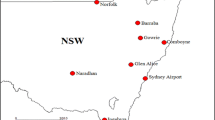Abstract
Comprehensive flood prevention plans are established in large basins to cope with recent abnormal floods in South Korea. In order to make economically effective plans, appropriate design rainfalls are critically determined from the rainfall depth-frequency curves which take the occurrence of abnormal floods into consideration. Conventional approaches to construct the rainfall depth-frequency curves are based on the stationarity assumption. However, this assumption has a critical weak aspect in that it cannot reflect non-stationarities in rainfall observations. As an alternative, this study suggests the non-stationary Gumbel model (NSGM) which incorporates a linear trend of rainfall observations into rainfall frequency analysis to construct the rainfall depth-frequency curves. A comparison of various schemes employed in the model found that the proposed NSGM permits the estimation of the distribution parameters even when shifted in the future by using linear relationships between rainfall statistics and distribution parameters, and produces more acceptable estimates of design rainfalls in the future than the conventional model. The NSGM was applied at several stations in South Korea and then expected the design rainfalls to increase by up to 15–30% in 2050.







Similar content being viewed by others
References
Communities and Local Government (2010) Planning policy statement 25: Development and flood risk, London
Conover WJ (1971) Practical nonparametric statistics. Wiley, New York
Cunderlik JM, Burn DH (2003) Non-stationary pooled flood frequency analysis. J Hydrol 276:210–223
Dooge JCI, Kuusisto E, Askew A, Bergström A, Bonnell M, Burn D, Edmunds WM, Feddes RA, Hall A, Kundzewicz Z, Liebscher HJ, Lins H, Llasat MC, Lucero O, Pilon P, Roald L, Saelthun NR, Schädler B, Shiklomanov I, Strupczewski WG, Vailmäe R, Varis O, Vorosmarty C (1998) Climate and water—a 1998 perspective. In: Proceedings of the second international conference on climate and water, Espoo
Ekström M, Fowler HK, Kilsby CG, Jones PD (2005) New estimates of future changes in extreme rainfall across the UK using regional climate model integrations 2. Future estimates and use in impact studies. J Hydrol 300:234–251
El Adlouni S, Ouarda TBMJ, Zhang X, Roy R, Bobée B (2007) Generalized maximum likelihood estimators for the nonstationary generalized extreme value model. Water Resour Res 43:W03410. doi:10.1029/2005WR004545
Fowler HK, Ekstöm M, Kilsby CG, Jones PD (2005) New estimates of future changes in extreme rainfall across the UK using regional climate model integrations 1. Assessment of control climate. J Hydrol 300:212–233
Hamilton LC (1992) Regression with graphics: a second course in applied statistics. Duxbury Press, Belmont
He Y, Bárdossy A, Brommundt J (2006) Non-stationary flood frequency analysis in southern Germany. In: Proceedings of the seventh international conference on hydroscience and engineering, Philadelphia
Jung I-W, Bae D-H, Kim G (2011) Recent trends of mean and extreme precipitation in Korea. Int J Climatol 31:359–370
Katz RW, Parlange MB, Naveau P (2002) Statistics of extremes in hydrology. Adv Water Resour 25:1287–1304
Khaliq MN, Ouarda TBMJ, Ondo J-C, Gachon P, Bobée B (2006) Frequency analysis of a sequence of dependent and/or non-stationary hydro-meteorological observations: a review. J Hydrol 329:534–552
Kuusisto E, Lemmelã R, Liebscher H, Nobilis F (1994) Climate and water in Europe; some recent issues. Technical report of Rapporteurs—Working Group on Hydrology, World Meteorological Organization, Helsinki
Mathworks (2010) Optimization toolbox: user’s guide. The Mathworks Inc., Natick
McCuen RH (2002) Modeling hydrologic change: statistical methods. Lewis Publishers, Washington
Ministry of Construction and Transport (MOCT) (2000) Maps for design rainfalls in South Korea. Report for the research and development of water resources management in 1999, Seoul
Park J-S, Kang H-S, Lee YS, Lim M-K (2010) Changes in the extreme daily rainfall in South Korea. Int J Climatol doi:10.1002/joc.2236
Ramesh NI, Davison AC (2002) Local models for exploratory analysis of hydrological extremes. J Hydrol 256:106–119
Renard B, Lang M, Bois P (2006) Statistical analysis of extreme events in a non-stationary context via a Bayesian framework: case study with peak-over-threshold data. Stoch Environ Res Risk Assess 21:97–112
Sankarasubramanian A, Lall U (2003) Flood quantiles in a changing climate: seasonal forecasts and causal relations. Water Resour Res 29(5). doi:10.1029/2002WR001593
Stakhiv G (2010) Practical approaches to water management under climate change uncertainty. Workshop on nonstationarity, hydrologic frequency analysis, and water management. Colorado Water Institute Information Series, No. 109
Strupczewski WG, Kaczmarek Z (2001) Non-stationary approach to at-site flood frequency modeling. II. Weighted least squares estimation. J Hydrol 248:143–151
Strupczewski WG, Singh VP, Feluch W (2001a) Non-stationary approach to at-site flood frequency modeling. I. Maximum likelihood estimation. J Hydrol 248:123–142
Strupczewski WG, Singh VP, Mitosek HT (2001b) Non-stationary approach to at-site flood frequency modeling. III. Flood analysis of Polish rivers. J Hydrol 248:152–167
Zhang X, Zweirs FW, Li G (2004) Monte Carlo experiments on the detection of trends in extreme values. J Clim 17:1945–1952
Acknowledgments
This work was supported by grants from the National Research Foundation (No. 2010-0015578), Ministry of Education, Science and Technology, and Natural Hazard Mitigation Research Group (NEMA-NH-2010-35), National Emergency Management Agency, South Korea. All supports are gratefully acknowledged. Dr. Ungtae Kim at the University of Tennessee is thanked for his technical assistance on the modeling. The authors also thank the anonymous reviewers for their constructive comments and corrections.
Author information
Authors and Affiliations
Corresponding author
Additional information
For Stochastic Environmental Research and Risk Assessment November 29, 2011.
Rights and permissions
About this article
Cite this article
Seo, L., Kim, TW., Choi, M. et al. Constructing rainfall depth-frequency curves considering a linear trend in rainfall observations. Stoch Environ Res Risk Assess 26, 419–427 (2012). https://doi.org/10.1007/s00477-011-0549-6
Published:
Issue Date:
DOI: https://doi.org/10.1007/s00477-011-0549-6




